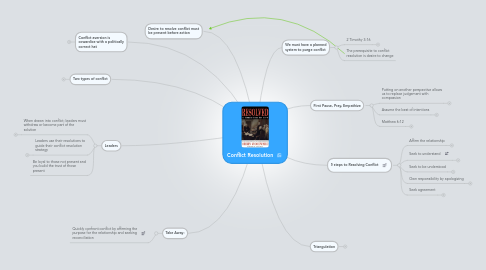
1. Two types of conflict
1.1. Silence
1.1.1. Harboring unresolved conflict
1.1.2. Fearing confrontation more than fearing end result of conflict
1.2. Violence
1.2.1. Gossip
1.2.2. Physical attack
1.2.3. Both based in cowardice
2. We must have a planned system to purge conflict
2.1. 2 Timothy 3:16
2.1.1. All scripture is given by inspiration of God, and is profitable for doctrine, for reproof, for correction, for instruction in righteousness:
2.2. The prerequisite to conflict resolution is desire to change
3. Conflict aversion is cowardice with a politically correct hat
3.1. Cowardice must be rooted out entirely
3.2. 2 timothy 1:7
3.2.1. For God hath not given us the spirit of fear; but of power, and of love, and of a sound mind.
3.3. Conflict aversion can also be a result of lack of belief
4. Leaders
4.1. When drawn into conflict; leaders must withdraw or become part of the solution
4.1.1. apologize first
4.1.1.1. Encourage second
4.1.1.1.1. Never criticize directly
4.2. Leaders use their resolutions to guide their conflict resolution strategy
4.2.1. Conflict builds on purpose, friendship, scoreboard
4.2.1.1. Common interest
4.2.1.1.1. Consistent encouragement
4.3. Be loyal to those not present and you build the trust of those present
5. First Pause, Pray, Empathize
5.1. Putting on another perspective allows us to replace judgement with compassion
5.1.1. Philippians 2:3-4
5.1.1.1. Let nothing be done through strife or vainglory; but in lowliness of mind let each esteem other better than themselves. 4 Look not every man on his own things, but every man also on the things of others.
5.2. Assume the best of intentions
5.2.1. Focus on the time spent fellowshipping rather than on the conflict
5.3. Matthew 6:12
5.3.1. And forgive us our debts, as we forgive our debtors.
6. Triangulation
6.1. Pulling someone in or being pulled into a conflict unless you're being pulled in as a mediator / to solve the problem.
6.1.1. Mediator cannot influence the conversation with their own thoughts.
6.2. Venting is an avoidance technique that creates triangulation.
6.3. 3 people
6.3.1. Victim
6.3.2. Persecutor
6.3.3. Rescuer
6.4. Proverbs 20:19
6.4.1. He that goeth about as a talebearer revealeth secrets: therefore meddle not with him that flattereth with his lips.
6.5. Ephesians 4:29
6.5.1. Let no corrupt communication proceed out of your mouth, but that which is good to the use of edifying, that it may minister grace unto the hearers.
6.6. Proverbs 16:28
6.6.1. A froward man soweth strife: and a whisperer separateth chief friends.
6.7. Proverbs 21:23
6.7.1. Whoso keepeth his mouth and his tongue keepeth his soul from troubles.
6.8. Matthew 5:9
6.8.1. Blessed are the peacemakers: for they shall be called the children of God.
7. 5 steps to Resolving Conflict
7.1. Affirm the relationship
7.1.1. Encourage
7.1.2. Place high value on relationship and on reward of working it out.
7.1.3. The goal of affirmation is that both parties are validated as valuable members of the relationship.
7.1.4. Listening is the best way to affirm
7.1.4.1. Romans 14:19
7.1.4.1.1. Let us therefore follow after the things which make for peace, and things wherewith one may edify another.
7.1.4.2. Proverbs 27:2
7.1.4.2.1. Let another man praise thee, and not thine own mouth; a stranger, and not thine own lips.
7.1.5. Deposit in the love and respect tanks
7.2. Seek to understand
7.2.1. Listen intently
7.2.1.1. Attempt to see from other party's perspective
7.2.1.1.1. Be curious; not furious!
7.2.1.2. Do NOT assign motives; just clarify actions
7.2.1.2.1. James 1:19
7.3. Seek to be understood
7.3.1. Re-establish intention of good communication
7.3.1.1. Proverbs 18:13
7.3.1.1.1. Make the goal of clear communication clear!
7.3.1.1.2. He that answereth a matter before he heareth it, it is folly and shame unto him.
7.3.2. It is 100% my responsibility to communicate my message clearly and it is 100% your responsibility to ensure you receive my message
7.4. Own responsibility by apologizing
7.4.1. Own as much of conflict as possible while still being truthful
7.4.1.1. Leaders look for teachable moments
7.4.1.1.1. A genuine apology creates goodwill
7.5. Seek agreement
7.5.1. Agree on future roles and responsibilities for future relationship
7.5.1.1. Agreement creates stronger bonds and fills the commitment bucket
7.5.1.1.1. Romans 12: 4 - 5
7.5.1.1.2. Agreement leads to new/renewed purpose for relationship
